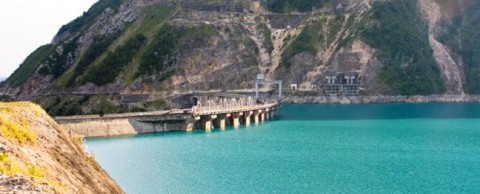Khudoni, Georgia’s largest hydropower investment project, is again making the headlines. According to a recent statement by Georgia’s Minister of Energy and Natural Resources Kakha Kaladze, the project will be put on hold at least until March 1, 2014. To give readers a bit of context, Khudoni’s planned capacity is in excess of 700 MW; its annual generation potential stands at about 1,5 TW/h, dwarfing other hydropower projects currently under MoUs with international investors. If built, Khudoni would be the second largest HPP in Georgia after Enguri, which has installed capacity of 1,320 MW, and annual production potential of up to 3.8 TW/h.
The initial MoU between the Georgian government and Continental Energy International (later to be renamed Trans Electrica Ltd) was signed in June 2007. A fierce debate has been raging ever since over the terms of concession, the perceived benefits of increased electricity production, and its cost in terms of environmental damages caused by the construction of the 200m dam.
To be sure, Khudoni is a very complex project, making its cost-benefit analysis anything but simple. Yet, the two sides involved in this debate tend to ignore these complexities, being swayed either by the green ideology or greed. While the green party exclusively focuses on the environmental costs of the project, the other sees nothing but gains (certainly private, but also public, in the form of increased electricity supply). And, neither side provides reliable estimates to support their claims.
Even leaving environmental considerations aside, there are purely economic reasons to be concerned with the general energy strategy that has been ruthlessly (and, perhaps, mindlessly) pursued by the previous Georgian administration.
Indeed, the demand for electricity has been on the rise since 2009 and investment in new generation capacity is lagging behind (see chart). Yet, the massive investment in hydropower will not be able to significantly improve Georgia’s energy balance in the dry winter months, when demand peaks for seasonal reasons, forcing Georgia to revert to much more expensive thermal generation and imports.

Second, the Build-Own-Operate (BOO) concession model, which Georgia used to attract foreign investors, allows them to pocket the lion’s share of economic rents accruing from the use of Georgian natural resources. At least as far as large projects, such as Khudoni are concerned, the public revenue, raised in the form of the transmission tariff, seems a modest return on the massive capital outlays and environmental impacts.
Third, instead of prioritizing electricity exports and investing scarce public resources in export-oriented transmission infrastructure, Georgia should consider the option of making greater domestic use of its cheap energy resources so as to spur investment in energy-intensive industries that could export higher value-added and more sophisticated products.
To sum up, the choices facing Georgia are far from trivial. This is true about its future energy policy in general, and the technically and environmentally complex large hydropower investment projects in particular. The cost of mistakes could be quite high and the new Georgian‘s government's intent to re-open and scrutinize previous agreements is fully understandable. Taking a pause now will allow basing future decisions on Social Cost-Benefit Analysis (SCBA) of Khudoni and similar projects in terms of their full economic costs and benefits. (The special feature of SCBA is that it takes into account the existence of external effects and their impact on social welfare.)
While perhaps falling short of the SCBA ideal, the “Advisory Review of the Environmental and Social Impact Assessment (ESIA) of the Khudoni Hydropower Project”, recently published by the Ministry of Energy and Environment, is a small step in the right direction.

















Comments
Having achieved the stable operation of the energy sector over the last decade, the time is ripe for the country to make a detailed analysis of the sector and its contribution to the national economy which should result in a strategy for developing the energy sector. This is a key policy document so that all stakeholders (government, investors, energy companies and consumers) use as a reference for decision-making.
The devil lies in the fact that planning beyond an electoral cycle is not that appealing for politicians.
Indeed, policy document is probably the most important document. Without having objectives it is difficult to decide what does country need - Khudoni or wind power plant.
Nice post!
It is interesting, why they stick to only hydropower when there is need and possibility to diversify the sources of energy in the country.